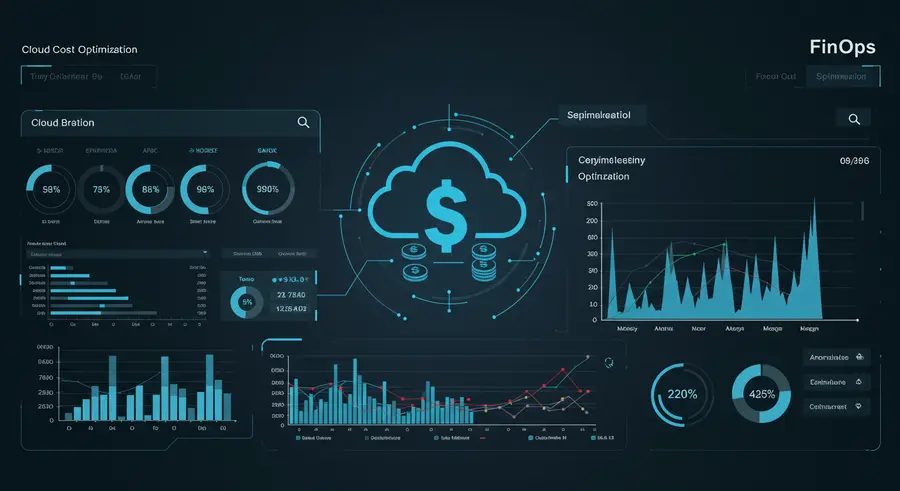Appearance

Welcome, innovators and cloud enthusiasts! 👋 Today, we're diving deep into the world of FinOps, exploring advanced strategies to master cloud cost optimization. In an era where cloud spending is a significant part of IT budgets, understanding and implementing effective FinOps practices is no longer optional—it's a necessity for sustainable growth and innovation.
What is FinOps? A Quick Recap 💡
FinOps, or Cloud Financial Operations, is an evolving cultural practice that brings financial accountability to the variable spend model of cloud. It's about empowering teams to make data-driven spending decisions, fostering collaboration between finance, operations, and engineering teams. The core principles of FinOps are:
- Collaboration: Breaking down silos between teams.
- Visibility: Understanding where and how cloud spend is occurring.
- Optimization: Continuously improving cloud efficiency and reducing waste.
For a foundational understanding, you can check out our catalogue page on FinOps: Managing Cloud Costs Effectively.
Why Advanced FinOps Strategies Now? 🚀
While basic FinOps practices provide a solid foundation, the dynamic nature of cloud environments demands more sophisticated approaches. As cloud adoption matures, so too must our strategies for managing its financial impact. Advanced FinOps goes beyond simple cost visibility, focusing on proactive optimization, automation, and a deeper integration of financial principles into technical operations.
Key Pillars of Advanced FinOps 🏗️
Let's explore some cutting-edge strategies that will elevate your cloud cost optimization efforts:
1. Granular Cost Allocation and Tagging Excellence 🏷️
The foundation of any robust FinOps practice is accurate cost allocation. Advanced strategies involve:
- Mandatory Tagging Policies: Enforce consistent and comprehensive tagging across all cloud resources. This allows for precise cost attribution to specific teams, projects, environments, and applications.
- Automated Tagging Enforcement: Utilize policy-as-code tools to automatically enforce tagging standards and remediate non-compliant resources.
- Hierarchical Tagging: Implement a multi-level tagging hierarchy to provide both high-level and detailed cost breakdowns.
Example: Imagine a complex microservices architecture. Without proper tagging, it's nearly impossible to know which service is consuming the most resources. With granular tagging, you can attribute costs down to individual services, empowering service owners to optimize their own spend.
2. AI-Driven Continuous Optimization 🤖
Move beyond reactive cost management to proactive, AI-driven optimization.
- Predictive Analytics: Leverage machine learning to forecast future cloud spend based on historical data and projected growth. This helps in proactive budgeting and identifying potential cost overruns.
- Anomaly Detection: Implement AI-powered tools to detect unusual spend patterns in real-time, alerting teams to potential waste or misconfigurations.
- Automated Rightsizing and Scaling: Utilize AI and automation to continuously rightsize resources to match actual workloads and implement intelligent auto-scaling policies that optimize for both performance and cost.
Example: An AI model could analyze your historical compute usage and recommend optimal instance types and sizes, or even suggest when to scale down resources during off-peak hours, saving significant costs without manual intervention.
3. FinOps-as-Code and GitOps Integration 💻
Treat your FinOps policies and configurations as code, managing them with version control and continuous integration/continuous deployment (CI/CD) pipelines.
- Infrastructure as Code (IaC) for FinOps: Define cost controls, budgeting policies, and tagging standards within your IaC templates (e.g., Terraform, CloudFormation).
- Automated Policy Enforcement: Integrate FinOps policies into your CI/CD pipelines to ensure compliance before resources are provisioned.
- Version Control: Track changes to your FinOps policies, allowing for easy rollbacks and auditing.
Example: A developer proposes a new service. Before deployment, a FinOps-as-Code pipeline could automatically check if the proposed resources adhere to cost policies and tagging standards, preventing costly mistakes before they happen.
4. Unit Economics and Business Value Alignment 💲
Shift the focus from just reducing costs to understanding the cost per unit of business value.
- Cost per Customer/Transaction: Calculate the cloud cost associated with each customer, transaction, or other relevant business metric. This provides a more meaningful perspective on efficiency.
- Showback/Chargeback Mechanisms: Implement transparent showback or chargeback models to make teams accountable for their cloud consumption and encourage cost-conscious decisions.
- ROI-Driven Optimization: Prioritize optimization efforts based on their potential return on investment (ROI) and impact on business objectives.
Example: Instead of just seeing a large bill for a database, understanding the cost per API call or per user for that database allows product teams to make informed decisions about feature development and optimization.
5. Cross-Functional Cloud Center of Excellence (CCoE) 🤝
Establish or strengthen a CCoE that includes representatives from finance, engineering, operations, and business units.
- Shared Goals and Metrics: Ensure all teams are aligned on FinOps goals and understand how their actions impact cloud spend.
- Regular Review Meetings: Conduct frequent meetings to review cloud spend, identify optimization opportunities, and discuss new cloud initiatives.
- Training and Education: Provide continuous training on cloud economics, cost optimization techniques, and FinOps best practices to all relevant stakeholders.
Example: A CCoE can serve as a central hub for sharing best practices, resolving cost-related challenges, and driving a culture of cost awareness across the organization.
The Future is Frugal and Collaborative 💡
Mastering FinOps is an ongoing journey that requires continuous effort, adaptation, and a strong commitment to collaboration. By embracing these advanced strategies, organizations can not only significantly reduce their cloud spend but also foster a culture of financial responsibility and innovation. The goal isn't just to save money, but to spend smarter, enabling faster innovation and better business outcomes in the cloud.
Happy optimizing! 🚀